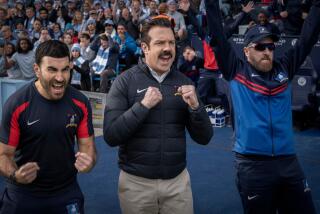‘Chill’ Blew Over Quickly, but ‘Cool’ Has Staying Power
NEW YORK — Groovy is over, hip is square, far out is long gone. Don’t worry, though -- it’s cool.
“Cool” remains the gold standard of slang in the 21st century, as reliable as a blue-chip stock, surviving as few expressions ever have in our constantly evolving language. It has kept its cool through the centuries -- even as its meaning changed drastically.
How cool is that?
Way cool, say experts who interpret slang for their messages about society.
“Cool is certainly a charter member for the slang hall of fame,” says Robert Thompson, a Syracuse University professor of popular culture. “Cool just sits back and keeps getting used generation after generation and lets the whole history of the language roll off its back.”
Thompson estimates he uses the word 50 times a day “as an egghead professor” because no other word quite does the job. He says its versatility helps explain its staying power.
It is the all-purpose word for OK, good, great, terrific and every gradation in between, often pronounced nowadays as “kewl.”
Before it became slang, cool was, of course, a literal reference to temperature, and later a favorite metaphor of writers as far back as Chaucer in the 1300s. In 1602, Shakespeare wrote that Queen Gertrude told Hamlet: “O gentle son / Upon the heat and flame of thy distemper / Sprinkle cool patience.”
By the 17th century, the word helped define a woman’s ability to allay a man’s passion through sex. During the horse-and-buggy era, “cooling one’s heels” described the need to rest a horse with overheated hoofs. The 1800s saw the use of “cool off,” meaning to kill, and the “cool customer.”
Early in the 20th century, it was used to refer to large amounts of money: “a cool million.” In the 1920s, Calvin Coolidge’s White House campaign slogan was “Keep Cool With Coolidge.” By the 1930s, “cool as a cucumber” was “the bee’s knees” -- slang of the era for “excellent.”
But by the 1940s, cool gained popularity through its use in jazz clubs, where musicians employed a word that had already enjoyed wide use among blacks.
The 1997 book “America in So Many Words” traces the modern usage of cool to the late 1940s. In 1947, the book notes, the Charlie Parker Quartet recorded “Cool Blues.”
A year later, Life magazine titled an article “Bebop: New Jazz School Is Led by Trumpeter Who Is Hot, Cool and Gone.” And in 1948, the New Yorker said “the bebop people have a language of their own.
Geoffrey Nunberg, a linguist at UC Berkeley, says the word should have faded away at the end of the ‘50s. Instead, it was adopted and redefined by hippies, followed by surfers, rappers and techno-geeks. “Click here for cool stuff,” websites say.
Peter N. Stearns, a social historian at George Mason University and author of the book “American Cool,” says cool went mainstream in the 1950s and ‘60s because society needed a word to express attitude without anger.
“We were dealing with a culture that was placing an increasing premium on controlling emotion, particularly anger,” he says. Hippies used the word to “promote the notion that they were relaxed and not angry.”
Since then, he says, the expression has lost some of its vigor because of overuse. “When we say somebody’s looking cool, we don’t have as much sense of meaning as we did 40 years ago,” he says. “Now we just mean he’s looking good.”
Thompson says there is no reason to believe that cool will go the way of linguistic dinosaurs like “bad” (meaning good), or “chill” (meaning cool off).
“Cool is already firmly ensconced in several generations,” he says. “It’s got street cred. And it had street cred before we even used the word ‘street cred.’ ”
More to Read
Sign up for Essential California
The most important California stories and recommendations in your inbox every morning.
You may occasionally receive promotional content from the Los Angeles Times.










